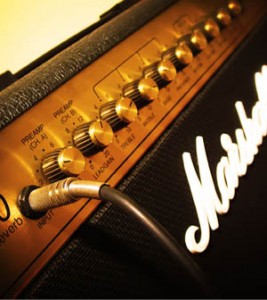A Crash Course In Choosing Your First Amp
So you walk into a music store, spot a cool-looking amplifier, plug your axe in and bust out your favorite solo (which hopefully isn’t “Stairway to Heaven”, for the staff’s sake).
Does it have that ear-rattling, teeth-chattering crunch you’re looking for? It sounds nice enough, and it might even seem like love at first sight (or first riff in this case).
But hold on a second – don’t take that amp home just yet.
Until you really know what you’re looking for, you should consider a handful of factors first.
Here’s a rundown of points to consider when picking out the perfect amp for your shredding needs:
#1: What’s Your Type?
While amps come in all shapes and sizes, they fall under four basic categories.
The first one is called solid-State, which essentially runs on semiconductors. The great thing about them is that they’re low-maintenance and don’t need too much fixing in the long run.
Usually a staple for guitarists who are hopping from one gig to another – or for practice sessions – solid state amps have earned a reputation for their reliability. They usually come in two varieties, with or without distortion.
Tube amps, on the other hand, have more of a warmer, fatter tone as opposed to the solid-State’s clean tone. Also, you’ll need to change the tubes from time to time as they’re subject to wear and tear. Tube amps are known for being louder than their solid-state counterparts and have a distinct flavor all their own, thanks to a unique distortion often referred to as “organic” (which can be controlled by switching between channels).
Then there’s the digital variety known as modeling amps that replicate the analog sound of their tube counterparts. Since they run on software, modeling amps can emulate different types of other amps, utilize various effects and even plug them into a recording system directly.
Hybrid amps, as the name suggests, are a mix of both tube and solid-state technology that often involves a tube setup for the preamp side, while the power section has the solid-state side. This results in a “tube tone” even though there aren’t power tubes built in.
#2: Apples and Oranges
Ok, that might be a lot to take in. Let’s cut through the confusion, shall we?
Solid-state enthusiasts will tell you that the advantage of such technology is the clean power, and that they’re reasonably priced compared to other amps, like the tube variety for instance.
That’s why hybrid amps have been a choice for many guitarists to get the best of both worlds since they combine solid-state and tube amps like I explained earlier.
However, there are tube aficionados who don’t mind the heftier price tag (mainly because there aren’t many tube amps in production as before).
As for modeling amps, they’re known for their versatility because of the programmable tones and effects that we talked about. Also, there are enough types of modeling amps to fit a specific need, like for practice or in the studio.
And unless you’re a vintage buff (who are usually tube amp users or experienced guitarists), you’re not going to mind that modeling amps can digitally recreate a wide range of classic tones and configurations (such a head and amp combination called a “stack”) on demand.
Click HERE to read the rest of the article…







You must be logged in to post a comment Login